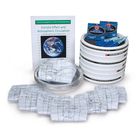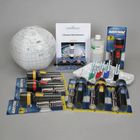Modeling the Coriolis Effect

The Coriolis effect is named after Gustave Gaspard Coriolis, a 19th-century French professor of mechanical engineering. He calculated much of the mathematics behind the effect. The theory explains the apparent deviation in the path of winds and water currents across the earth. Although Coriolis’ interest was in the various forces acting upon rotating pieces of machinery, the Coriolis effect is a topic in earth, environmental, and marine science. The effect can be a tough concept to explain, but it is fairly easy to model. The phenomenon can be demonstrated with a simple and inexpensive balloon activity.
Because the earth rotates (from west to east around a north-south axis), paths of objects moving great distances across the earth’s surface are deflected. If a plane left the North Pole, flying south toward Portland, Maine, and maintained that straight-line path for a period of time, the pilot might actually land in Portland, Oregon instead. From the perspective of a person standing in Portland, Maine, who had somehow been able to watch the entire flight, the plane would have veered far to the west, or to the right of the straight path, as seen from the North Pole. Similarly, both Anchorage and Los Angeles rotate once in a 24-hour day. Los Angeles “travels” farther and faster in that time period because it is on a lower latitude. Students need to picture this phenomenon clearly before they can comprehend the Coriolis effect and its impact on weather systems and ocean currents.
This activity takes approximately 15 minutes to complete. You can assess student understanding with the questions and answers provided. The extension activities introduce the meteorological and oceanographic applications of the activity.
The activity addresses these dimensions of the Next Generation Science Standards*(NGSS):
| Science and Engineering Practices | Disciplinary Core Ideas | Crosscutting Concepts |
| Practice: Developing and using models • Students will model the apparent deflection of a straight path known as the Coriolis effect. |
DCI: ESS2-Earth’s systems • Students will understand that the Coriolis effect helps explain the motions of both weather systems and ocean currents. |
Concept: Cause and Effect: Mechanism and explanation • Students will understand that the rotation of the earth explains the apparent deflection of a straight-line path. |
Materials (per each student pair)
- 1 Balloon (round)
- 2 Permanent Markers (different colors; visible when applied to balloons)
Preparation
- Divide the class into working pairs.
- Provide each pair with a balloon and 2 markers.
- Project the questions on your board so that the students can answer them as they work (optional).
Procedure
- Blow up a balloon.
- With a marker, draw the equator on the balloon midway between the knot and the top of the balloon. Label the top North Pole and the knot South Pole.
- Hold the balloon at eye level, by the knot, and rotate it left to right, simulating the rotation of the earth.
- While 1 partner rotates the earth balloon, the other examines the movement of the earth from the North Pole perspective and from the South Pole perspective. Answer questions 1 and 2.
- While 1 partner continues to rotate the balloon steadily from left to right, the other slowly tries to draw a line straight from the North Pole, south to the equator, using a second marker. While the earth continues to rotate, 1 partner tries to draw a straight line from the South Pole, north to the equator. Answer questions 3 and 4.
Students may struggle with understanding that the direction of the earth’s movement is based on their point of view. When they describe the direction (left or right) that the “straight” lines veer, make sure that the students determine this direction from the perspective of the beginning point of the line. Take a few minutes to discuss this as a class. You may also address common misconceptions concerning the Coriolis effect, such as the notion that the direction of swirl in a flushing toilet differs in the northern and southern hemispheres.
Extension Activities
- Have students relate the directional movement of large air masses, ocean currents, and hurricanes to the Coriolis effect. They may find maps that depict the prevailing winds and ocean currents in the northern and southern hemispheres.
- Change the rotational speed of the balloon and compare the amount of “curve” between a slow and fast rotation.
- If you have access to a merry-go-round, have some students sit at various points on the perimeter and face the center. While someone spins the merry-go-round, have a student on the merry-go-round try to roll a ball straight toward the person directly across from him/her. Vary the speed and rotation of the merry-go-round, as well as the speed of the ball, and discuss any differences. Have students relate this demonstration to the Coriolis effect. If you do not have access to a merry-go-round, you can conduct similar demonstrations using a turntable and marbles, but without the perspective of someone actually on the rotating object.
- Use our Coriolis Effect and Atmospheric Circulation Kit (item #181091).
Questions and answers
- As you look from the North Pole toward the equator, is the balloon spinning clockwise or counterclockwise?
The balloon appears to be spinning counterclockwise. - As you look from the South Pole toward the equator, is the balloon spinning clockwise or counterclockwise?
The balloon appears to be spinning clockwise. - What happened when you tried to draw a straight line from the North Pole to the equator?
The line was not straight but instead veered west or right of the intended path. - What happened when you tried to draw a straight line from the South Pole to the equator?
The line was not straight but instead veered west or left of the intended path. - Predict what would happen if you again drew lines in the northern and southern hemispheres but with the earth rotating in the opposite direction.
The curving of the objects in the northern and southern hemispheres would be reversed. Objects moving from the North Pole to the equator would veer to the left of their path and objects moving from the South Pole toward the equator would veer to the right of their path (toward the east, in both cases).
*Next Generation Science Standards® (NGSS) is a registered trademark of Achieve. Neither Achieve nor the lead states and partners that developed the Next Generation Science Standards were involved in the production of, and do not endorse, these products.







